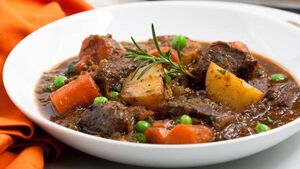Living Greener: No need to sweat over what to cook

Beef and Guinness Stew
IN the last few generations, cookery books – and shows, and channels, and web sites – have grown exponentially into a thousand increasingly ambitious iterations. I can flip across channels and see twee British ladies judging food sculptures under a tent; Japanese chefs wrestling live octopuses, and fat men sitting in diners shouting at the camera and gorging themselves.
I can walk through the bookstore and see vast aisles of cookbooks, all with giant, breathtaking photographs of meticulously-crafted meals in decorative chinaware in extravagant kitchens.
Yet while all this has been happening, the number of people who cook for themselves keeps going down; in the UK from 1980 to 2000 alone, one study found the share of ingredients purchased for home cooking declined by 40 per cent. Fast food joints, ready-meals and junk food have proliferated in the same decades that cooking shows and cookbooks have exploded. Why?
The key might lie in the fact that all of these shows and books are consumer products, with images designed to pound your emotional buttons and then disappear. By making food into complicated art pieces for display, and cooking into an aggressive competition, they make it seem arduous craft for elites rather than something we all did every day until recently.
If you want to make simple dishes at home, first relax. If you don’t have an ingredient, the chances are that you can substitute something or leave it out. Buy a list of simple staples like flour, rice, and barley that will keep forever, along with oil and butter, salt and pepper.
Buy some small plants and plant them inside your kitchen window, or right outside your back door: parsley, marjoram, thyme, sage, scallions, sorrel. Then, when you plan your dishes for the week, buy a few easy vegetables and some good meat, and whatever other perishables you need.
On dark winter nights we all need some comfort food, and this is a perfect dish for that, using ingredients easily obtainable from the local shop.
500 grams of diced stew beef
2 large onions
2 cloves of garlic
1 carrot
Salt, pepper, herbs
Put a pan on medium heat and add a few tablespoons of oil. Add the meat and stir them around with a wooden spoon while you dice the onions. When the meat is light brown, remove it and add the diced onions to the pan, stirring occasionally while you mash or thinly slice the garlic. When the onions are golden brown add the garlic and stir around for about 30 seconds, then add the meat back in and add salt, pepper, two teaspoons of dried marjoram and half a teaspoon of thyme.
Pour in a can of Guinness or other stout with an equal amount of water. Slice up and add the carrot – a parsnip will also do fine. Put four tablespoons of flour and half a cup of water to a sealable jar and shake it until all the lumps are out, and then add that to thicken.
Growing up in America, we often made chilli as a summer ritual for some reason, but it seems more appropriate for winter and spring; it uses canned, dried and easily stored ingredients, and as a heavy, warming stew it’s perfect for these still-cold days.
500g of pork mince
1 large onion
3 cloves of garlic
1 tin can of kidney beans or black beans
1 tin can of crushed tomatoes
1 cup of vegetable broth
Seasoning: oregano, paprika, cumin, coriander, cayenne, salt and pepper.
Dice the onion and fry in olive oil until soft, add minced garlic and stir, and add the mince and fry until brown. Add the tomatoes and kidney beans, then 1 teaspoon each of oregano, cumin, coriander and chili powder, plus salt and pepper to taste. Add the vegetable broth, and let simmer for a half hour.





